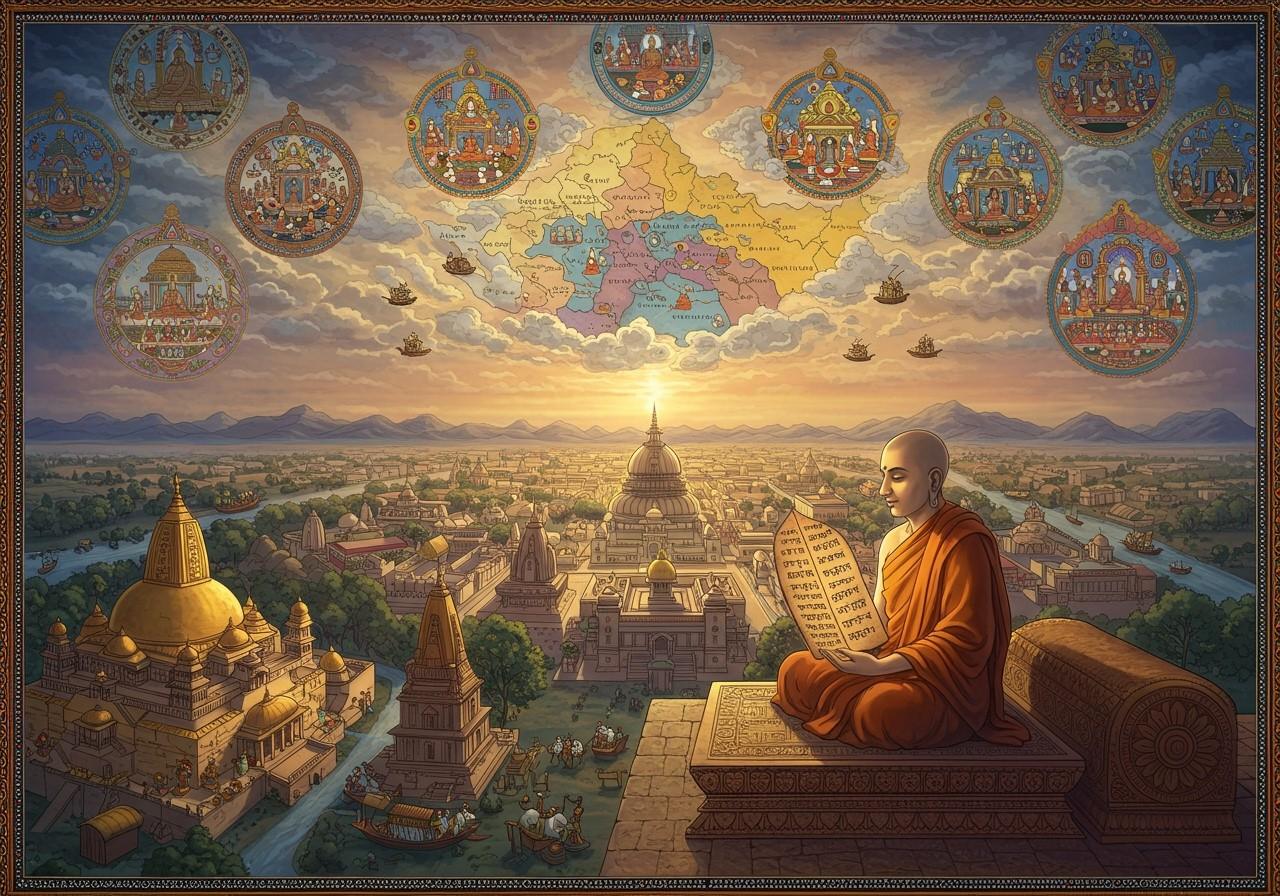
The Anguttara Nikaya, a key Buddhist scripture, provides valuable insights into the socio-political landscape of ancient India, particularly through its mention of the sixteen Mahajanapadas (great kingdoms) that flourished during the 6th century BCE. These kingdoms, emerging during the Vedic Age, played a crucial role in shaping the historical and cultural context in which Buddhism arose.
Background on Anguttara Nikaya
Understanding the Anguttara Nikaya
The Anguttara Nikaya, meaning “Increased by One Collection,” is a crucial part of the Sutta Pitaka within the Pali Canon. Its unique structure, organizing teachings numerically, aided memorization and preservation, especially during an era when oral transmission was prevalent. This systematic arrangement makes it a cornerstone of Buddhist scripture.
Historical Context
Compiled after Buddha’s lifetime (around the 3rd century BCE), the Anguttara Nikaya offers a glimpse into the lives and practices of early Buddhists. Its numerical organization reflects a unique approach to preserving teachings, proving invaluable in an era reliant on oral tradition. The text is divided into eleven nipatas or sections, further enhancing its structure and accessibility.
Historical Overview of Mahajanapadas
What Were the Mahajanapadas?
The Mahajanapadas represent sixteen prominent kingdoms or republics that thrived in ancient India from the 6th to 4th centuries BCE. Located across various regions, including present-day Bihar, Uttar Pradesh, and parts of central India, these kingdoms significantly influenced the political, social, and cultural landscape of the time.
Political and Social Structures
Each Mahajanapada possessed its own distinct governance system, ranging from monarchies to republics. Their economies relied on agriculture, trade, and diverse crafts. Interactions between these kingdoms, through both trade and conflict, played a pivotal role in shaping the cultural and religious dynamics of the era.
Anguttara Nikaya’s Mention of Mahajanapadas
Specific Passages
The Anguttara Nikaya’s multiple references to the Mahajanapadas provide a valuable glimpse into their political and social conditions. These mentions offer crucial historical context for understanding the backdrop against which the Buddha’s teachings emerged.
Significance of Mentions
These references hold significant weight as they corroborate information found in other historical records and ancient texts like the Digha Nikaya, Buddhist Mahavastu, and Jain Bhagavati Sutra. This cross-referencing strengthens our understanding of the environment in which Buddhism developed and spread, particularly during the period known as the Age of Sixteen Mahajanapadas (from the fall of Videha to the rise of Magadha).
Analysis of the 16 Mahajanapadas
Detailed Overview
The Anguttara Nikaya lists the following sixteen Mahajanapadas:
- Magadha: Known for powerful rulers and rich culture.
- Kosala: Played a significant role in early Buddhist history.
- Vajji: Famous for its republican form of government.
- Malla: Known for its warrior class.
- Chedi: Held a strategic location in central India.
- Vatsa: Important for its capital, Kaushambi.
- Kuru: Renowned for its traditions and rituals.
- Panchala: Known for its fertile lands.
- Matsya: Had strong agricultural foundations.
- Shurasena: Significant for its location near Mathura.
- Assaka: Located in the Deccan region.
- Avanti: Powerful in western India.
- Gandhara: Famous for its art and culture.
- Kamboja: Known for its cavalry.
- Anga: Had strategic importance near Magadha.
- Surasena: Played a role in spreading Buddhism.
These kingdoms were instrumental in shaping the socio-economic and political dynamics of ancient India, particularly during the 6th century BCE. Their inclusion in the Anguttara Nikaya underscores their historical significance.
Cultural and Religious Impact
The Anguttara Nikaya not only documents the existence of the Mahajanapadas but also highlights their cultural and religious contributions. These kingdoms significantly influenced the development of Buddhist thought and practice. Cultural exchanges between these kingdoms and Buddhist monks facilitated the dissemination of Buddhist teachings across the region.
The architectural and artistic expressions found in Buddhist sites bear the mark of these interactions. The Mahajanapadas played a crucial role in preserving and promoting the teachings enshrined in the Anguttara Nikaya, shaping the trajectory of Buddhism in ancient India.
Poojn.in: Your Resource for Cultural and Religious Items
Poojn.in, India’s leading cultural goods and services store, offers a wide selection of items relevant to the study and practice of Buddhism and the exploration of ancient Indian history. Whether you are seeking traditional ritual items, incense for meditation, or artifacts reminiscent of the Mahajanapada period, Poojn.in provides a convenient platform for acquiring authentic and high-quality products. Explore our collection today and discover how Poojn.in can enhance your understanding and appreciation of this rich heritage.
-
Explore our collection of incense sticks perfect for meditation and creating a serene atmosphere for your Buddhist practices.
-
Discover our range of prayer beads (malas) crafted from various materials, aiding in mindfulness and traditional practices.
-
Find authentic brass and copper items suitable for offerings and rituals, connecting you to ancient traditions.
Conclusion
The Anguttara Nikaya, through its structured teachings and references to the Mahajanapadas, offers a unique lens for understanding the socio-political landscape of ancient India during the 6th century BCE. These sixteen kingdoms played a crucial role in shaping the historical and cultural context for the emergence and spread of Buddhism. By studying these connections, we gain a deeper appreciation of the interplay between Buddhist teachings and the environment in which they flourished. This exploration highlights the importance of preserving historical texts like the Anguttara Nikaya, which provide invaluable insights into our rich cultural heritage.
Hanuman’s Journey: Devotion, Strength, and Epic Tale
Lord Rama: Ideal Leadership and Virtue
Hindu Philosophy Explained: A Beginner’s Guide
Hindu Symbols Explained: Their Meanings and Importance


